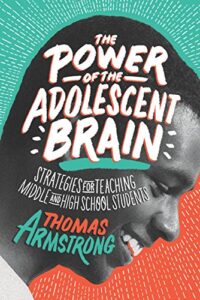 Thomas Armstrong, Ph.D. is the Executive Director of the American Institute for Learning and Human Development, and an award-winning author and speaker who has been an educator for over forty years. Over one million copies of his books are in print in English on issues related to learning and human development. And he is the author of 16 powerful books including Neurodiversity in the Classroom, Multiple Intelligences in the Classroom, In Their Own Way, Awakening Your Child’s Natural Genius, The Human Odyssey … and the list goes on. He is also a friend and I’ve had the immense honor of speaking at several conferences with him. Thomas has made an enormous contribution to the field of education.
Thomas Armstrong, Ph.D. is the Executive Director of the American Institute for Learning and Human Development, and an award-winning author and speaker who has been an educator for over forty years. Over one million copies of his books are in print in English on issues related to learning and human development. And he is the author of 16 powerful books including Neurodiversity in the Classroom, Multiple Intelligences in the Classroom, In Their Own Way, Awakening Your Child’s Natural Genius, The Human Odyssey … and the list goes on. He is also a friend and I’ve had the immense honor of speaking at several conferences with him. Thomas has made an enormous contribution to the field of education.
His latest book, The Power of the Adolescent Brain: Strategies for Teaching Middle and High School Students, is a must read for educators. He looks at the power and promise of the teenage brain from an empathetic, strength-based perspective–and describes what middle and high school educators can do to make the most of their students’ potential. As with each of his writings, the book is grounded in the latest neuroscience research. Thomas also explains what we know about how the adolescent brain works and proposes eight essential instructional elements that will help students develop the ability to think, make healthy choices, regulate their emotions, handle social conflict, consolidate their identities, and learn enough about the world to move into adulthood with dignity and grace. Most important, he shows that there is a major mismatch between how the adolescent brain has evolved over the millennia and the passive, rote learning experiences that are all too common in today’s test-obsessed educational climate and offers ways to help students tap into the power of their changing brains.
Here is a description of The Power of the Adolescent Brain that Thomas graciously wrote for me.
A Special Blog Post by Dr. Thomas Armstrong
 Our teens have a hard time of it any way you slice the tomato. They’re vulnerable to depression, eating disorders, substance abuse, Internet addiction, and that’s just the short end of the list. But they have this marvelous neuroplastic brain which can change depending upon what’s there for it in the surrounding world. That means we can make a profound impact on our adolescents’ brains if we choose to do so.
Our teens have a hard time of it any way you slice the tomato. They’re vulnerable to depression, eating disorders, substance abuse, Internet addiction, and that’s just the short end of the list. But they have this marvelous neuroplastic brain which can change depending upon what’s there for it in the surrounding world. That means we can make a profound impact on our adolescents’ brains if we choose to do so.
In my book The Power of the Adolescent Brain, I suggest eight key strategies that educators can implement right away to help ensure that our teens’ brains develop in an optimal way. For healthy brain development, students in middle and high school need:
- Frequent opportunities to make choices in the classroom;
- Metacognitive activities to sharpen their intellect;
- Self-awareness exercises to help them consolidate their identities;
- Physical learning to activate the highly neuroplastic cerebellum and reduce stress;
- Expressive arts integrated into the curriculum to channel all that emotional energy coming up from the limbic system of the brain;
- Real world experiences to challenge them to make good decisions in the midst of authentic (and not artifical classroom) change;
- Peer learning activities to take advantage of adolescents’ hunger for approval and connection with their fellow students;
- Affective learning (for example, using humor in the classroom and teaching about controversial topics) to integrate the emotional brain with the reasoning brain in the prefrontal cortex
Some schools are already doing wonderful things to help implement these changes. But by and large, our middle and high schools tend to be either ‘’brain-ignorant,’’ (unaware of adolescent brain development) or even ‘’brain-hostile,’’ especially when they do some of the following:
- Heap on required courses (preventing teens from making their own choices)
- Cut back on recess and PE (raising stress levels)
- Deliver content through dry lectures and spiritless textbooks (which causes disengagement of the emotional brain)
- Post grades and test scores for all to see (humiliating students in front of their peers)
- Teach ‘’fact learning’’ rather than engaging students in thinking things out for themselves.
The way we can stop ‘’brain-hostile’’ teaching and implement more ‘’brain-friendly’’ strategies is by addressing adolescent brain development in professional development programs for educators, and by teaching students about how their own brains work. Studies show that when students learn, for example, that their minds are not fixed in place but can change over time, their stress levels go down and their achievement levels go up.
It’s time to change the conversation about high school reform from raising test scores to teaching in a developmentally appropriate way.
Thomas Armstrong, Ph.D. is the author of sixteen books including The Power of the Adolescent Brain: Strategies for Teaching Middle and High School Students.

